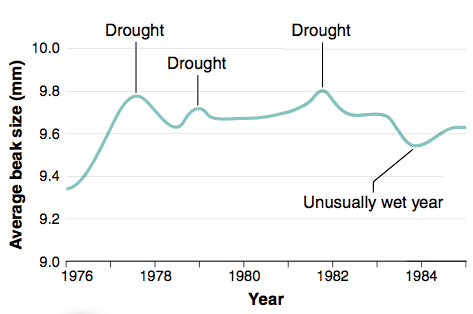Chapter 8. Chapter 8 Graphic Content
Introduction
Graphic Content
true
true
You must read each slide, and complete the question on the slide, before proceeding to the next one.

Instructions
Review the information provided in the graph to answer each question below.
After submitting your answer, you will be provided feedback to check if your response is correct.
(This activity contains 6 questions.)
Question 8.1

The curvy line represents the average beak size of Galápagos finches, measured from 1976 to 1985.
Question 8.2

The “average” beak size is calculated from measures of many birds. If more birds with large beaks die in a particular year, the average will be lower. If birds with larger beaks are healthier and reproduce at a higher rate than birds with small beaks during that year, the average will increase.
Question 8.3

Each time there was a drought, the average beak size increased a bit. During the wet year, the average beak size decreased. It seems as though the environment is influencing which birds are most successful.
Question 8.4

Based on this figure, it appears that when the climate gets drier, birds with larger beaks survive and reproduce better than birds with smaller beaks. Similarly, when the climate is wetter, birds with smaller beaks are more plentiful. So having information about annual rainfall would be useful in making predictions about average beak size in these finches.
Question 8.5

There is no “optimum” beak size. Rather, the beak size that leads to the greatest survival and reproduction varies from year to year and is dependent on the amount of rainfall.
Question 8.6

Traits in a population can vary in fitness, depending on the environment. There is no such thing as a better trait or a worse trait. A trait is better or worse in a particular environment.
Activity results are being submitted...